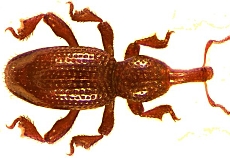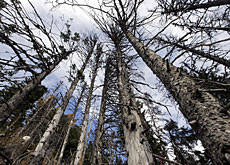Oldest Basel inhabitant is pure weevil

Swiss insect specialists have discovered an animal that has called Basel home for over two million years, yet has gone unnoticed until now.
The two-millimetre-long Raymondionymus marqueti weevil is believed to have colonised the area before any of the recorded ice ages.
According to Basel University beetle specialist Andreas Kaupp, the discovery is nothing less than “sensational”.
It is the first time this insect has been seen in central Europe. A similar discovery was made in the Geneva area, but this is considered a different geographical zone.
Raymondionymus marqueti, a blind weevil, probably survived glaciations thanks to the steep, sunny and dry location of its habitat opposite the point where the Birs River enters the River Rhine.
The area where the weevil was found is the site of the first protected zone in Switzerland. This south-facing stretch along the Rhine offers climate conditions close to those found nearer the Mediterranean.
Surprise find
The beetle’s presence in the area was certainly a surprise for specialists. The insect was found by accident during a study of grassed areas.
“It wasn’t in our list of central European beetles,” Eva Sprecher of Basel’s natural history museum told the Basler Zeitung newspaper.
It was only after consulting specialised literature and checking Italian specimens in the museum’s own collection of beetles that the scientists were sure they had come across a rarity.
Raymondionymus marqueti lives about 40 centimetres underground, but isn’t just blind. It can’t fly either and has legs not unlike those of a mole.
The researchers know that it eats plant matter, but don’t know how long its lifespan is. According to Kaupp, it was only found after it was driven above ground by heavy rain and fell into an insect trap.
The insect specialists are sure that the weevil didn’t just arrive in town recently. Given its underground lifestyle and its specific adaptation to its environment, Kaupp reckons that it is a prehistoric remnant – much older than other local animal and plant species that have colonised the area in the past 10,000 years.
Further research is now required to decide whether the weevil is a distinct species deserving its own name: Raymondionymus basiliensis. More work will also be carried to find out how the weevil lives.
swissinfo with agencies
Weevils are usually small, less than 6 millimetres in length, and herbivorous.
There are over 60,000 species in several families, mostly in the family Curculionidae (the true weevils).
Many weevils are damaging to crops. The grain or wheat weevil damages stored grain. The boll weevil attacks cotton crops. It lays its eggs inside unripe cotton bolls, and the young weevils eat their way out.
Weevils are most likely to be observed in a domestic setting when opening a bag of flour although they will happily infest most types of grain including oats, barley and breakfast cereals.
If ingested, E. coli infection and other various diseases can be contracted from weevils, depending on their diet.

In compliance with the JTI standards
More: SWI swissinfo.ch certified by the Journalism Trust Initiative

You can find an overview of ongoing debates with our journalists here. Please join us!
If you want to start a conversation about a topic raised in this article or want to report factual errors, email us at english@swissinfo.ch.